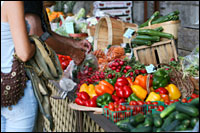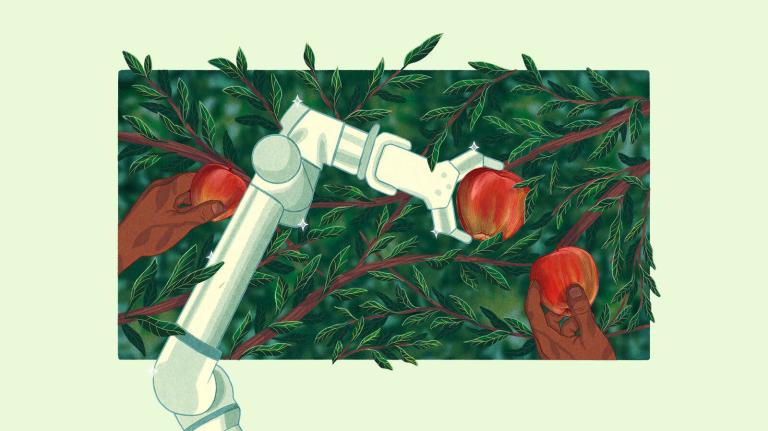Edible Media takes an occasional look at interesting or deplorable food journalism.
Whatever else it has accomplished, the local-food movement has certainly conquered the appetites of New York’s influential food-media editors.

Following the lead of Gourmet, glossy mags like Food & Wine and Bon Appetit now offer regular paeans to place-based eating. The New York Times Wednesday food section sometimes seems like the house organ of the city’s burgeoning eat-local scene — and often covers the topic in locales across the country as well.
As predictably as night follows day, this rise to fashionable status has inspired doubters. That’s fine. Movements need criticism, including self-criticism, or they risk congealing into mindless orthodoxy. A couple of times in Victual Reality (here and here), I’ve addressed some high-profile critiques of eating close to home.
Now I’ll look at another kind of response to eating locally — the avuncular embrace from high-profile writers who can barely conceal their feeling that it’s all just a fad. These writers patronize local food as something fun that the kids are getting up to, but don’t see it as a serious movement.
I’m thinking of Adam Gopnik, staff writer of The New Yorker. I’ve never been a big fan of Gopnik’s. Too often, he writes a kind of smart-guy-in-the-know prose: more interested in displaying his own wit and knowledge than really digging into a topic.
Gopnik’s latest piece, appearing in the magazine’s venerable annual food issue (currently on the shelves, dated Sept. 3/10), takes on what he calls “extreme localism” in eating. In what now feels like a very familiar narrative device, the article recounts his picaresque journey around New York City’s boroughs to gather ingredients for a meal to be cooked at home for his friends. In the process, Gopnik meets some of the city’s cutting edge food producers: a Brooklyn farmer (my friend Ian Marvy of Added Value), a rooftop beekeeper, a city-park forager, and a man who raises chickens in the Bronx.
It’s all very charming, except that these mini-profiles lack depth. It’s as if there’s a tacit joke between Gopnik and his in-the-know readers: Get a load of this guy! He’s growing vegetables on an asphalt playground in Brooklyn! What a character!
The trip is so entertaining that Gopnik can’t resist bringing his kids along for the ride, and squeezing a bit of comedy out of them. That aspect of the story actually worked for me, because it helps Gopnik make an important point:
To shorten the food chain is to pull it close, close enough to put a face on one’s food and a familiar place on one’s plate. To eat something local is to meet someone nearby. We had put the city, from Brooklyn ingenuity and Bronx Zoo manure to a slaughterhouse on 168th Street, on a plate, and eaten it up. The plates had stories, where they normally have only food.
That’s good stuff. But Gopnik also indulges in some high-toned philosophizing that’s really pretty facile. At the end of the article, when he’s telling us what we should think of his experiment in culinary localism, we get this:
There are powerful arguments against localism: apart from the inevitable statistical tussles about exactly how much fuel is used for how much food, the one word that never occurs in the evocation of the lost world of small citie and nearby farms is “famine.” Our peasant ancestors, who lived locally and ate seasonally from the fruit of their ow vines and the meat of their own lambs, were hungry all the time. The localist vision of the tiny polis and it surrounding gardens has historically led to bitter conflict, not Arcadian harmony.
Fair enough. This is an important point, one often lost amid eat-local sloganeering. In its 10,000-year history, agriculture has generally meant eating locally — and the specter of famine has always crept along at its edges, ready to pounce. Around 50 years ago, we managed to industrialize agriculture, ramp up its productivity, and smooth out its rough edges with technology.
In the West at least, famine has become an abstract thing (although people should remember that in World War II, some half million Europeans died of hunger).
But is industrial ag’s triumph the end of the story, as Gopnik suggests? Not likely. Sure, industrial agriculture has made famine seem obsolete or at least distant, relegated to “developing countries” that haven’t embraced artificial fertilizers, etc.
But in historical terms, industrial ag was born yesterday. In its half-century reign, chemical-intensive farming has mined the soil so thoroughly, and so steadily eroded the genetic diversity of key crops, that it may have seriously comprised its ability to produce food in the long term. To say nothing of its reliance on fossil fuel.
In short, rather than imperiling the food security of discrete villages and cities, as Gopnik accuses the “localist vision” of doing, industrial ag may be imperiling food security over a broad swath of the globe.
Of course, there’s no need for either/or thinking — the first recourse of sloganeers and facile writers. Why can’t we knit revitalized local and regional food economies into the current global one — creating a hybrid one that maximizes the benefits of localism while minimizing the threat of famine? The thought never occurs to Gopnik.
Gopnik goes on to level what he sees as a second devastating critique of eat-local: the class issue.
It is even perilously easy to construct a Veblenian explanation for the vogue for localism. Where a century ago all upwardly mobile people knew enough, and had enough resources, to get their hands on the most unseasonable foods from the most distant places, in order to distinguish themselves from the peasant past and the laboring masses, their descendants now distinguish themselves by hustling after a peasant diet.
It’s so “perilously easy” to make such a critique that I did so myself two years ago. Again, Gopnik chooses to score rhetorical points rather than dig in deep. Lots of people are working hard to overcome the brutal paradoxes of local food and class. One of them in fact is Ian Marvy, Gopnik’s Brooklyn farmer, whose program Added Value explicitly uses food production as a way to build wealth and skills in an economically devastated neighborhood — and make high-quality food accessible in the process. (Here’s a profile I did of Added Value a while back.)
Gopnik doesn’t get into any of this. Rather, he summarizes Added Value as “socially ambitious” and leaves it at that — and lets his own “Veblenian explanation” of local food hang there, as if no one were answering it.
In all, a disappointing performance — an exercise in glibness over depth — by a prominent writer in what’s probably our most influential magazine.
Mark Bittman in Naples
One food writer whose work I almost always admire is Mark Bittman, author of the indispensable Minimalist column in the Wednesday New York Times.
Last week, he did a did a wonderful piece on a restaurant in Naples, Italy, a place where people eat a lot of local food without fussing much about it.
Here’s how he describes La Tavernetta, a restaurant he says separates “food lovers from dining aficionados”:
Professionals, laborers, families and the Old World version of ladies who lunch all sit elbow to elbow, munching on their crunchy, moist meatballs, their calamari with peas, their sausage with greens.
Sounds like paradise. I love how, in places where people really love to eat, great, moderately priced food attracts a diverse array of people. At a spectacular sausage stand in Vienna, I once saw businessmen in $2,000 suits standing elbow to elbow with construction workers. I’ve seen the same thing at great taquerias in Mexico City as well.
It’s something I wish I saw more of here in the United States.
